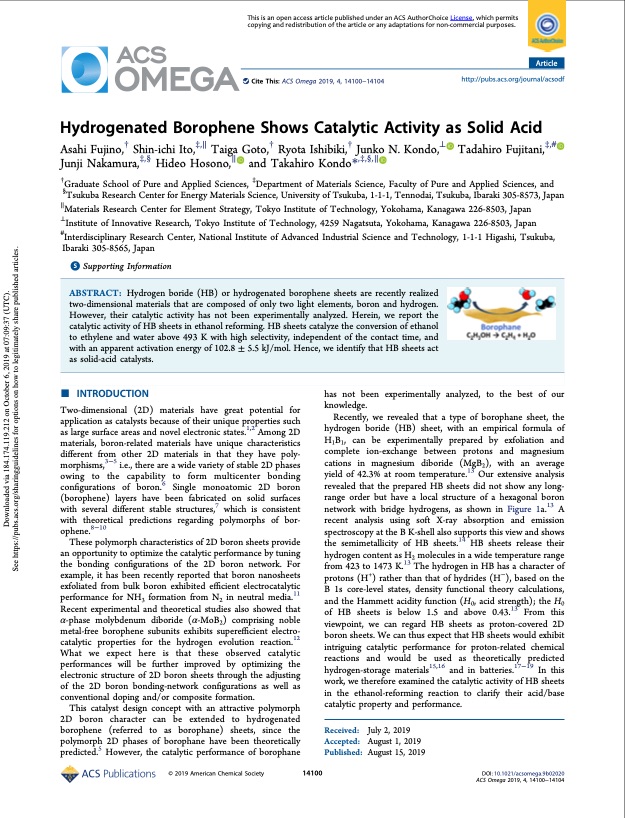
PDF Publication Title:
Text from PDF Page: 002
This is an open access article published under an ACS AuthorChoice License, which permits copying and redistribution of the article or any adaptations for non-commercial purposes. Article Cite This: ACS Omega 2019, 4, 14100−14104 http://pubs.acs.org/journal/acsodf Hydrogenated Borophene Shows Catalytic Activity as Solid Acid Asahi Fujino,† Shin-ichi Ito,‡,∥ Taiga Goto,† Ryota Ishibiki,† Junko N. Kondo,⊥ Tadahiro Fujitani,‡,# Junji Nakamura,‡,§ Hideo Hosono,∥ and Takahiro Kondo*,‡,§,∥ †Graduate School of Pure and Applied Sciences, ‡Department of Materials Science, Faculty of Pure and Applied Sciences, and §Tsukuba Research Center for Energy Materials Science, University of Tsukuba, 1-1-1, Tennodai, Tsukuba, Ibaraki 305-8573, Japan ∥Materials Research Center for Element Strategy, Tokyo Institute of Technology, Yokohama, Kanagawa 226-8503, Japan ⊥Institute of Innovative Research, Tokyo Institute of Technology, 4259 Nagatsuta, Yokohama, Kanagawa 226-8503, Japan #Interdisciplinary Research Center, National Institute of Advanced Industrial Science and Technology, 1-1-1 Higashi, Tsukuba, Ibaraki 305-8565, Japan *S Supporting Information ABSTRACT: Hydrogen boride (HB) or hydrogenated borophene sheets are recently realized two-dimensional materials that are composed of only two light elements, boron and hydrogen. However, their catalytic activity has not been experimentally analyzed. Herein, we report the catalytic activity of HB sheets in ethanol reforming. HB sheets catalyze the conversion of ethanol to ethylene and water above 493 K with high selectivity, independent of the contact time, and with an apparent activation energy of 102.8 ± 5.5 kJ/mol. Hence, we identify that HB sheets act as solid-acid catalysts. ■ INTRODUCTION Two-dimensional (2D) materials have great potential for application as catalysts because of their unique properties such as large surface areas and novel electronic states.1,2 Among 2D materials, boron-related materials have unique characteristics different from other 2D materials in that they have poly- morphisms,3−5 i.e., there are a wide variety of stable 2D phases owing to the capability to form multicenter bonding configurations of boron.6 Single monoatomic 2D boron (borophene) layers have been fabricated on solid surfaces with several different stable structures,7 which is consistent with theoretical predictions regarding polymorphs of bor- ophene.8−10 These polymorph characteristics of 2D boron sheets provide an opportunity to optimize the catalytic performance by tuning the bonding configurations of the 2D boron network. For example, it has been recently reported that boron nanosheets exfoliated from bulk boron exhibited efficient electrocatalytic performance for NH3 formation from N2 in neutral media.11 Recent experimental and theoretical studies also showed that α-phase molybdenum diboride (α-MoB2) comprising noble metal-free borophene subunits exhibits superefficient electro- catalytic properties for the hydrogen evolution reaction.12 What we expect here is that these observed catalytic performances will be further improved by optimizing the electronic structure of 2D boron sheets through the adjusting of the 2D boron bonding-network configurations as well as conventional doping and/or composite formation. This catalyst design concept with an attractive polymorph 2D boron character can be extended to hydrogenated borophene (referred to as borophane) sheets, since the polymorph 2D phases of borophane have been theoretically predicted.5 However, the catalytic performance of borophane © 2019 American Chemical Society 14100 has not been experimentally analyzed, to the best of our knowledge. Recently, we revealed that a type of borophane sheet, the hydrogen boride (HB) sheet, with an empirical formula of H1B1, can be experimentally prepared by exfoliation and complete ion-exchange between protons and magnesium cations in magnesium diboride (MgB2), with an average yield of 42.3% at room temperature.13 Our extensive analysis revealed that the prepared HB sheets did not show any long- range order but have a local structure of a hexagonal boron network with bridge hydrogens, as shown in Figure 1a.13 A recent analysis using soft X-ray absorption and emission spectroscopy at the B K-shell also supports this view and shows the semimetallicity of HB sheets.14 HB sheets release their hydrogen content as H2 molecules in a wide temperature range from 423 to 1473 K.13 The hydrogen in HB has a character of protons (H+) rather than that of hydrides (H−), based on the B 1s core-level states, density functional theory calculations, and the Hammett acidity function (H0, acid strength); the H0 of HB sheets is below 1.5 and above 0.43.13 From this viewpoint, we can regard HB sheets as proton-covered 2D boron sheets. We can thus expect that HB sheets would exhibit intriguing catalytic performance for proton-related chemical reactions and would be used as theoretically predicted hydrogen-storage materials15,16 and in batteries.17−19 In this work, we therefore examined the catalytic activity of HB sheets in the ethanol-reforming reaction to clarify their acid/base catalytic property and performance. Received: July 2, 2019 Accepted: August 1, 2019 Published: August 15, 2019 DOI: 10.1021/acsomega.9b02020 ACS Omega 2019, 4, 14100−14104 Downloaded via 184.174.119.212 on October 6, 2019 at 07:09:37 (UTC). See https://pubs.acs.org/sharingguidelines for options on how to legitimately share published articles.PDF Image | Hydrogenated Borophene Shows Catalytic Activity as Solid Acid

PDF Search Title:
Hydrogenated Borophene Shows Catalytic Activity as Solid AcidOriginal File Name Searched:
Hydrogenated_Borophene_Shows_Catalytic_Activity_as.pdfDIY PDF Search: Google It | Yahoo | Bing
CO2 Organic Rankine Cycle Experimenter Platform The supercritical CO2 phase change system is both a heat pump and organic rankine cycle which can be used for those purposes and as a supercritical extractor for advanced subcritical and supercritical extraction technology. Uses include producing nanoparticles, precious metal CO2 extraction, lithium battery recycling, and other applications... More Info
Heat Pumps CO2 ORC Heat Pump System Platform More Info
| CONTACT TEL: 608-238-6001 Email: greg@infinityturbine.com | RSS | AMP |